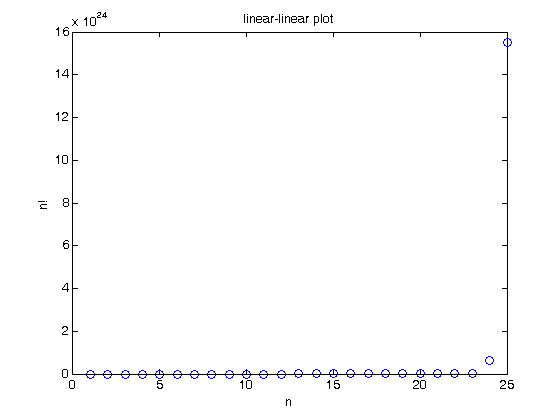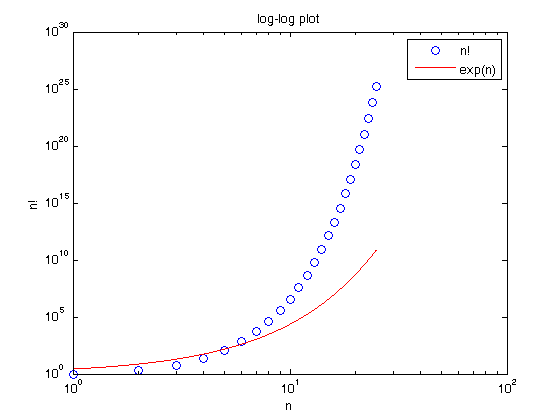% Jake Bobowski % July 27, 2017 % Created using MATLAB R2014a % This tutorial will demonstrate some implementations of nested control % structures in MATLAB. Nested structures very quickly become complicated % and hard to decipher. It is a very good idea to indent your code so that % it is easier to read/follow. MATLAB does a nice job of automatically % inserting these indentations. clearvars % In the while loop tutorial we should how you could calculate factorials % using while loops. Suppose you wanted to restrict users to inputing only % integer values of n. You can do this by placing your while loop inside % an if statement. The if statement will be used to check for valid % values of n. % First, I introduce the mod function. mod(y, x) outputs the modulus of % y/x. mod(5, 2) mod(4, 2) % We can use mod(n, 1) to check that n is an integer. mod(5.2, 1) mod(5, 1) % So, here is our first nested set of control structures. n = 4.3; if mod(n, 1) == 0 disp(['n = ' num2str(n)]) factorial = 1; while n > 1 factorial = factorial*n; n = n-1; end disp(['n! = ' num2str(factorial)]) else disp(['Invalid entry: n is noninteger.']) end % Notice that we can still trick the system into producing nonsense by % entering a negative integer. n = -4; if mod(n, 1) == 0 disp(['n = ' num2str(n)]) factorial = 1; while n > 1 factorial = factorial*n; n = n-1; end disp(['n! = ' num2str(factorial)]) else disp(['Invalid entry: n is noninteger.']) end % To fix this problem, we need to check that n is an integer AND positive. % We will use && to indicate a logical 'and' in our if statement. (We % could use &, but that will evaluate both the lefthand and righthand % conditions all of the time. && will only consider the righthand % condition if the lefthand condition is true. i.e. && will save some % computation time is some instances). We will also implement some elseif % statements so that we can present proper error messages. % In the elseif statements ~= means 'not equal to' and <= means 'less than % or equal to'. Try different entries for n. If you enter, for example, a % string for n you'll get an error message from MATLAB. As you can see, % accounting for all the possible silly inputs users could enter tracks a % lot of though and careful programming! n = -4.3; if mod(n, 1) == 0 && n > 0 disp(['n = ' num2str(n)]) factorial = 1; while n > 1 factorial = factorial*n; n = n-1; end disp(['n! = ' num2str(factorial)]) elseif n == 0 disp(['n = ' num2str(n)]) disp(['n! = 1']) elseif mod(n, 1) ~= 0 && n > 0 disp(['Invalid entry: n is noninteger.']) elseif mod(n, 1) == 0 && n < 0 disp(['Invalid entry: n negative.']) elseif mod(n, 1) ~= 0 && n < 0 disp(['Invalid entry: n is noninteger and negative.']) end % Now let's put our factorial code into a for loop so that we can calculate % n! as a function of n. start = 0; finish = 25; ns = (start:finish); facts = zeros(finish-start+1, 1)'; for i = start:finish n = i; if mod(n, 1) == 0 && n > 0 factorial = 1; while n > 1 factorial = factorial*n; n = n-1; end facts(i + 1) = factorial; elseif n == 0 facts(i + 1) = 1; elseif mod(n, 1) ~= 0 && n > 0 disp(['Invalid entry: n is noninteger.']) elseif mod(n, 1) == 0 && n < 0 disp(['Invalid entry: n negative.']) elseif mod(n, 1) ~= 0 && n < 0 disp(['Invalid entry: n is noninteger and negative.']) end end % We can now easily make a plot of n! vs n. Notice how sharply n! rises. plot(ns, facts, 'bo') ylabel('n!'); xlabel('n') title('linear-linear plot') % Here's the same data on a log-log scale. figure(); loglog(ns, facts, 'bo') ylabel('n!'); xlabel('n') title('log-log plot') hold on; % Here, we compare n! to exp(n). Above about n = 5, n! passes exp(n) and % continues to increase at a higher rate than exp(n). xx = (1:0.01:finish); yexp = exp(xx); loglog(xx, yexp, 'r-') legend('n!', 'exp(n)') hold off;
ans =
1
ans =
0
ans =
0.2000
ans =
0
Invalid entry: n is noninteger.
n = -4
n! = 1
Invalid entry: n is noninteger and negative.

